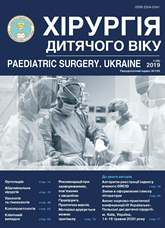Surgical managment of complicated gastroschisis. a single centre expirience
DOI:
https://doi.org/10.15574/PS.2019.65.35Keywords:
newborns, gastroschisis, complicated GS, atresia, stenosis, bowel necrosis, surgical treatmentAbstract
Treatment of complicated gastroschisis (GS) is associated with high morbidity and mortality. At present, there are still existing significant discrepancies in surgical tactics in newborns with complicated GS.Aim. The purpose of our study was to investigate the incidence rate and nature of complicated GS, its influence on the outcome of surgical treatment, as well as the effectiveness of various surgical treatment modalities.
Materials and methods. A retrospective analysis of medical records of 53 neonates with GS who were operated in our clinic using «first minute surgery» protocol from 2006 to 2017 was conducted. For the purpose of the study, all patients were divided into two groups. Group I included children with simple GS (n=40). Group II included newborns, who were diagnosed with complicated GS (n=13).
Results. Overall, 53 newborns with GS underwent surgical treatment, 13 (24.5%) children had complicated GS. Intestinal complications consisted of midgut atresia, stenosis or necrosis. We observed significant increase in the postoperative surgical complications rate (p=0.02), sepsis (p=0.03), term of full enteral nutrition (p<0.001) and hospital stay (p<0.001) in children with complicated GS. In newborns with complicated GS, patch repair of the anterior abdominal wall was used significantly more often (p=0.03).
Conclusions. Intestinal complications significantly affecting the outcome of surgical treatment of GS. The surgical approach depends on the degree of viscero-abdominal disproportion, the type of intestinal malformation and the presence of peel. A meta-analysis should be conducted to determine the optimal method of surgical treatment for these patients.
Level of evidence. Level III.
The research was carried out in accordance with the principles of the Helsinki Declaration. The study protocol was approved by the Local Ethics Committee of an institution. The informed consent of the patient was obtained for conducting the studies.
References
Sliepov OK, Migur MYu, Gordienko IYu, Ponomarenko OM et al. (2017). A case of small bowel obstruction of a rare etiology in a newborn with gastroschisis Paediatric Surgery.Ukraine.2(55): 27-31. https://doi.org/10.15574/PS.2017.55.27
Bergholz R, Boettcher M, Reinshagen K, Wenke K. (2014, Oct). Complex gastroschisis is a different entity to simple gastroschisis affecting morbidity and mortality – a systematic review and metaanalysis. J Pediatr Surg.49(10): 1527-32. https://doi.org/10.1016/j.jpedsurg.2014.08.001; PMid:25280661
Emil S, Canvasser N, Chen T, Friedrich E, Su W. (2012, Aug). Contemporary 2-year outcomes of complex gastroschisis. J Pediatr Surg.47(8): 1521-8. https://doi.org/10.1016/j.jpedsurg.2011.12.023; PMid:22901911
Hass HJ, Krause H, Herrmann K, Gerloff C, Meyer F. (2009, Dec). Colon triplication associated with ileum atresia in laparoschisis. Zentralbl Chir.134(6): 550-2. https://doi.org/10.1055/s-0028-1098762; PMid:19708012
Hijkoop A, IJsselstijn H, Wijnen RMH et al. (2017). Prenatal markers and longitudinal follow-up in simple and complex gastroschisis Archives of Disease in Childhood – Fetal and Neonatal Edition Published Online First: 14 June. https://doi.org/10.1136/archdischild-2016-312417; PMid:28615305
Houben C, Davenport M, Ade-Ajayi N, Flack N, Patel S. (2009, Feb). Closing gastroschisis: diagnosis, management, and outcomes. J Pediatr Surg.44(2): 343-7. https://doi.org/10.1016/j.jpedsurg.2008.10.084; PMid:19231531
Kimble RM, Blakelock R, Cass D. (1999). Vanishing gut in infants with gastroschisis. Pediatr Surg Int.15(7): 483-5. https://doi.org/10.1007/s003830050644; PMid:10525904
Kronfli R, Bradnock TJ, Sabharwal A. (2010, Sep). Intestinal atresia in association with gastroschisis: a 26-year review. Pediatr Surg Int.26(9): 891-4. https://doi.org/10.1007/s00383-010-2676-4; PMid:20676892
Kuleva M, Khen-Dunlop N, Dumez Y, Ville Y, Salomon LJ. (2012, Jan). Is complex gastroschisis predictable by prenatal ultrasound? BJOG.119(1): 102-9. https://doi.org/10.1111/j.1471-0528.2011.03183.x; PMid:22017923
Molik KA, Gingalewski CA, West KW, Rescorla FJ et al. (2001). Gastroschisis: a plea for risk categorization. J Pediatr Surg. 36: 51-5. https://doi.org/10.1053/jpsu.2001.20004; PMid:11150437
Natasha Hansraj, Shannon M. Larabee, Kimberly M. Lumpkins (2016). Anomalous mesenteric vessel – a rare etiology of intermittent partial small bowel obstruction. Journal of Surgical Case Reports.12: 1-3. https://doi.org/10.1093/jscr/rjw209; PMid:27908963 PMCid:PMC5675047
Ogunyemi D. (2001). Gastroschisis Complicated by Midgut Atresia, Absorption of Bowel, and Closure of the Abdominal Wall Defect. Fetal Diagn Ther.16: 227-230. https://doi.org/10.1159/000053915; PMid:11399884
Snyder CL, Miller KA, Sharp RJ, Murphy JP et al. (2001, Oct). Management of intestinal atresia in patients with gastroschisis. J Pediatr Surg.36(10): 1542-5. https://doi.org/10.1053/jpsu.2001.27040; PMid:11584405
Zachary Bauman, Victor Nanagas Jr. (2015). The Combination of Gastroschisis, Jejunal Atresia, and Colonic Atresia in a Newborn. Case Reports in Pediatrics Volume 2015, Article ID 129098: 4. https://doi.org/10.1155/2015/129098; PMid:26180651 PMCid:PMC4477220
Downloads
Issue
Section
License
The policy of the Journal “PAEDIATRIC SURGERY. UKRAINE” is compatible with the vast majority of funders' of open access and self-archiving policies. The journal provides immediate open access route being convinced that everyone – not only scientists - can benefit from research results, and publishes articles exclusively under open access distribution, with a Creative Commons Attribution-Noncommercial 4.0 international license(СС BY-NC).
Authors transfer the copyright to the Journal “PAEDIATRIC SURGERY.UKRAINE” when the manuscript is accepted for publication. Authors declare that this manuscript has not been published nor is under simultaneous consideration for publication elsewhere. After publication, the articles become freely available on-line to the public.
Readers have the right to use, distribute, and reproduce articles in any medium, provided the articles and the journal are properly cited.
The use of published materials for commercial purposes is strongly prohibited.

